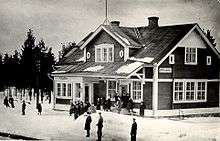Viipuri Province
| Viipuri Province Viipurin lääni Viborgs län | |||||
| Province of Finland | |||||
| |||||
|
Coat of arms | |||||
| Capital | Viipuri | ||||
| History | |||||
| • | Established | 1812 | |||
| • | Disestablished | 1945 | |||
| Area | |||||
| • | 1939¹ | 32,134 km2 (12,407 sq mi) | |||
| Population | |||||
| • | 1939¹ | 620,838 | |||
| Density | 19.3 /km2 (50 /sq mi) | ||||
| ¹ About 43 thousand km² with the surface of the Finnish part of Lake Ladoga. | |||||
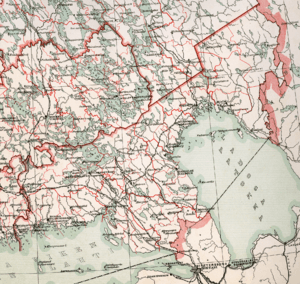
The Viipuri Province (Finnish: Viipurin lääni, commonly abbreviated Vpl, Swedish: Viborgs län or Wiborgs län) was a province of Finland from 1812 to 1945.
History
The predecessor of the province was Vyborg Governorate, which was established in 1744 from territories ceded by the Swedish Empire to Russia in 1721 (Treaty of Nystad) and in 1743 (Treaty of Åbo). These territories originated as parts of the County of Viborg and Nyslott and Kexholm County in 1721, and parts of the County of Savolax and Kymmenegård in 1743. The governorate was also known as Old Finland.
During the Napoleonic Wars, the Kingdom of Sweden had allied itself with the Russian Empire, United Kingdom and other parties against Napoleonic France. However, following the Treaty of Tilsit in 1807, Russia made peace with France. In 1808, supported by France, Russia successfully challenged Swedish control over Finland in the Finnish War. In the Treaty of Fredrikshamn on September 17, 1809, Sweden was obliged to cede all its territory in Finland east of the Torne River to Russia. The ceded territories became a part of the Russian Empire and were reconstituted into the autonomic Grand Duchy of Finland, with the Russian Tsar as Grand Duke.
In 1812, the territories of the Vyborg Governorate were transferred from Russia proper to the Grand Duchy of Finland and established as Viipuri Province. The transfer announced by Tsar Alexander I just before Christmas, on December 23, 1811 O.S. (January 4, 1812 N.S.), can be seen as a symbolic gesture and an attempt to appease the sentiment of the Finnish population, which had just experienced Russian conquest of their country by force. Siestarjoki was transferred to Saint Petersburg Governorate in 1864.
When Finland became independent from Russia in 1917, the status of Viipuri Province remained unchanged. The provincial capital, Vyborg (Swedish: Viborg, Finnish: Viipuri), was at this time the second largest city in Finland.
World War II
On September 1, 1939, Nazi Germany invaded Poland and started World War II. On September 17, 1939, the USSR, in accordance with the secret protocols of the Molotov–Ribbentrop Pact, invaded Poland from the east. Within months, the Soviet Union launched a war against Finland. As a result of this war, Finland was forced to cede territory, including parts of the province of Viipuri, to the Soviet Union in the Moscow Peace Treaty in early 1940. Finland lost its natural border along the Rajajoki River (Swedish: Systerbäck) in the south. 22,973 km², or 71.5 percent of the province on the Karelian Isthmus, including the cities of Viipuri and Sortavala, became part of the newly established Karelo-Finnish SSR in the Soviet Union. Following the peace treaty, the entire population of the ceded territories, more than four hundred thousand people, was evacuated to central Finland.
In 1941 the Continuation War broke out and Finland recaptured the territories, but in 1944 its forces were pushed back and by the Moscow Armistice on September 19, 1944, and the Paris Peace Treaty in 1947 the territorial losses were confirmed again.
Winter war evacuees had returned following the Finnish offensive in 1941 and were evacuated again in 1944 after the Soviet counterattack, and the territories were repopulated by people from other parts of the Soviet Union. This time, the Karelian Isthmus became part of the Vyborgsky and Priozersky districts of the Leningrad Oblast, and only Ladoga Karelia and Border Karelia became part of the Karelo-Finnish SSR.
While Ladoga Karelia retained most of its original toponyms, the vast majority of toponyms in the Karelian Isthmus were renamed by the Soviet government around 1948. In 1945 the parts of the province that remained in Finnish hands were renamed Kymi Province, with its center at Kouvola. The Kymi Province was in turn merged with other provinces into the larger Southern Finland Province in 1997.
 Provinces of Finland 1634: 1: Turku and Pori, 14: Nyland and Tavastehus, 18: Ostrobothnia, 20: Viborg and Nyslott, 21: Kexholm |
 Provinces of Finland 1721: 1: Turku and Pori, 14: Nyland and Tavastehus, 18: Ostrobothnia, 19: Kymmenegård and Nyslott |
 Provinces of Finland 1812:1: Turku and Pori, 4: Vaasa, 10: Oulu, 13: Viipuri, 14: Nyland and Tavastehus, 15: Kymmenegård, 16: Savolax and Karelia |
 Provinces of Finland 1831: 1: Turku and Pori, 2: Uusimaa, 3: Häme, 4: Vaasa, 6: Mikkeli, 8: Kuopio, 10: Oulu, 13: Viipuri |
 Provinces of Finland 1945: 1: Turku and Pori, 2: Uusimaa, 3: Häme, 4: Vaasa, 5: Kymi, 6: Mikkeli, 8: Kuopio, 10: Oulu, 11: Lapland, 12: Åland |
Economy
The area had a well-developed economy due to its proximity to Saint Petersburg, the capital of the Russian Empire. In 1856 Saimaa Canal (Russian: Сайменский канал, Saymensky kanal) was opened, linking Lake Saimaa and Finnish Lakeland to the Vyborg Bay.
The development of the province was bolstered further by the construction of the Saint Petersburg–Riihimäki railroad in 1870, the Viborg–Joensuu railroad in 1894 and the Petrograd–Hiitola railroad in 1917.
Granite, marble (in Ruskeala) and bog iron mining as well as logging were important branches of industry. Starting from the beginning of the 20th century, a number of hydroelectric power plants were built by Enso in the higher reaches of the River Vuoksi to supply its pulp and paper mills.
Administrative divisions
Local districts
In Finnish kihlakunta, in Swedish härad.
- Ranta (Swedish: Stranda)
- Äyräpää (Swedish: Äyräpää)
- Käkisalmi (Swedish: Kexholm)
- Kurkijoki (Swedish: Kronoborg)
- Kymi (Swedish: Kymmene)
- Lappee (Swedish: Lappvesi)
- Salmi (Swedish: Salmis)
- Sortavala (Swedish: Sordavala)
- Jääski (Swedish: Jäskis).
Cities, towns and municipalities in 1939
Those which were ceded to the Soviet Union during World War II are given in italics.
Cities
- Hamina - Fredrikshamn
- Kotka
- Käkisalmi - Kexholm
- Lappeenranta - Villmanstrand (website)
- Sortavala - Sordavala (website)
- Viipuri - Viborg (website 1, website 2)
Towns
- Kouvola
- Koivisto - Björkö (website)
- Lahdenpohja (website)
- Lauritsala (merged into Lappeenranta in 1967)
Rural municipalities
Finnish/Swedish name. Main village with the same name unless otherwise noted.
- Antrea - S:t Andree (website)
- Haapasaari - Aspö (merged into Kotka in 1974)
- Harlu (website)
- Heinjoki (website)
- Hiitola (website)
- Impilahti - Impilax (website)
- Jaakkima (website)
- Johannes (website) - S:t Johannes
- Joutseno (merged into Lappeenranta in 2009 (website)
- Jääski - Jäskis (partially lost, the rest incorporated into Imatra, Joutseno and Ruokolahti in 1948)
- Kanneljärvi (website)
- Kaukola (website)
- Kirvu - Kirvus (website)
- Kivennapa - Kivinebb (website)
- Koiviston maalaiskunta - Björkö landkommun (Koivisto rural commune) (website)
- Korpiselkä (partially lost, the rest incorporated into Tuupovaara in 1946) (website)
- Kuolemajärvi (website)
- Kurkijoki - Kronoborg (website)
- Kymi - Kymmene (merged into Kotka in 1977)
- Käkisalmen maalaiskunta - Kexholms landkommun (Käkisalmi rural commune)
- Lappee (merged into Lappeenranta in 1967) - Lappvesi
- Lavansaari - Lövskär (website)
- Lemi - Klemis
- Lumivaara (website)
- Luumäki
- Metsäpirtti (website)
- Miehikkälä
- Muolaa - Mohla (Kyyrölä merged into Muolaa in 1934) (website)
- Nuijamaa (merged into Lappeenranta in 1989)
- Parikkala (website)
- Pyhtää - Pyttis
- Pyhäjärvi (website)
- Rautjärvi (website)
- Rautu - Rautus (website)
- Ruokolahti - Ruokolax (website)
- Ruskeala
- Räisälä (website)
- Saari (merged into Parikkala in 2005) (website)
- Sakkola (website)
- Salmi - Salmis (website)
- Savitaipale
- Seiskari - Seitskär
- Simpele (merged into Rautjärvi in 1973)
- Sippola (merged into Anjalankoski in 1975)
- Soanlahti
- Sortavalan maalaiskunta - Sordavala landkommun (Sortavala rural commune)
- Suistamo (website)
- Suojärvi (website)
- Suomenniemi
- Suursaari - Hogland
- Säkkijärvi (partially lost, the rest incorporated into Miehikkälä and Ylämaa in 1946)
- Taipalsaari
- Terijoki (website)
- Tytärsaari - Tytärskär
- Uukuniemi (merged into Parikkala in 2005) (website)
- Uusikirkko - Nykyrka (website)
- Vahviala (partially lost, the rest incorporated into Lappee and Ylämaa in 1946)
- Valkeala (merged into Kouvola in 2009
- Valkjärvi (website)
- Vehkalahti - Veckelax (merged into Hamina in 2003)
- Viipurin maalaiskunta - Viborgs landkommun (Viipuri rural commune)
- Virolahti - Vederlax (website)
- Vuoksela (website)
- Vuoksenranta
- Ylämaa (merged into Lappeenranta in 2010 (website)
- Äyräpää (main village - Pölläkkälä)
Electoral districts
Following the electoral reform to the new Parliament of Finland in 1906, the province was divided into an Eastern and a Western electoral district.
Western electoral district
Haapasaari, Hamina, Johannes, Kanneljärvi, Koivisto, Koiviston maalaiskunta, Kotka, Kouvola, Kuolemajärvi, Kymi, Lappee, Lappeenranta, Lauritsala, Lavansaari, Lemi, Luumäki, Miehikkälä, Nuijamaa, Pyhtää, Savitaipale, Seiskari, Sippola, Suomenniemi, Suursaari, Säkkijärvi, Taipalsaari, Tytärsaari, Uusikirkko, Vahviala, Valkeala, Vehkalahti, Viipuri, Viipurin maalaiskunta, Virolahti, Ylämaa
Eastern electoral district
Antrea, Harlu, Heinjoki, Hiitola, Impilahti, Jaakkima, Joutseno, Jääski, Kaukola, Kirvu, Kivennapa, Korpiselkä, Kurkijoki, Käkisalmen maalaiskunta, Käkisalmi, Lahdenpohja, Lumivaara, Metsäpirtti, Muolaa, Parikkala, Pyhäjärvi, Rautjärvi, Rautu, Ruokolahti, Ruskeala, Räisälä, Sakkola, Salmi, Simpele, Soanlahti, Sortavala, Sortavalan maalaiskunta, Suistamo, Suojärvi, Terijoki, Uukuniemi, Valkjärvi, Vuoksela, Vuoksenranta, Äyräpää
Gallery
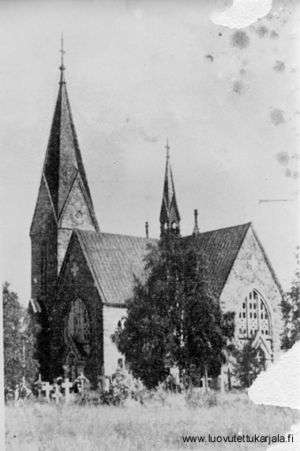 Kuolemajärvi Lutheran Church. Built in 1903, destroyed in 1939 |
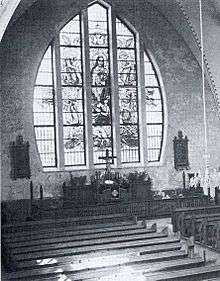 Lutheran Church in Koivisto designed by Josef Stenbäck |
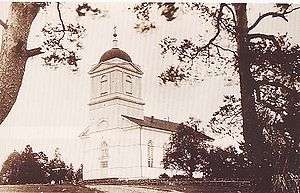 Muolaa Lutheran church. Built in 1849, destroyed during the Second World War |
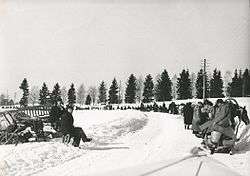 Evacuees from Muolaa municipality on their way to West-Finland, December 1939 |
 The old railway station in Elisenvaara, constructed around 1893, was destroyed in the Winter War |
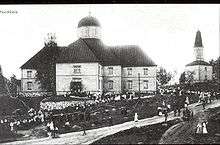 Parikkala old Lutheran Church. |
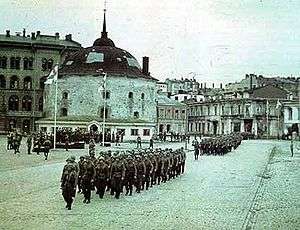 Finnish military parade in Viipuri on August 31, 1941, after its recapture |
Dam of the old private Finnish hydroelectric plant on Saijanjoki |
Governors
Governors of the Viipuri Province 1812-1945:

- Carl Johan Stjernvall 1812-1815
- Carl Johan Walleen 1816-1820
- Otto Wilhelm Klinckowström 1820-1821 (acting) ja 1821-1825
- Carl August Ramsay 1825-1827 (acting) and 1827–1834
- Carl Gustaf Mannerheim 1834-1839
- Fredric Stewen 1839-1844
- Casimir von Kothen 1844-1846 (acting) and 1846–1853
- Alexander Thesleff 1853-1856
- Bernhard Indrenius 1856-1866
- Christian Theodor Åker-Blom 1866-1882
- Woldemar von Daehn 1882-1885
- Sten Carl Tudeer 1885-1888 (acting) and 1888–1889
- Johan Axel Gripenberg 1889-1899
- Nikolai von Rechenberg 1900-1902
- Nikolai Mjasojedov 1902-1905
- Konstantin Kazansky 1905 (acting) and 1905
- Mikael von Medem 1905-1906 (acting)
- Nikolai von Rechenberg 190-1907
- Birger Gustaf Samuel von Troil 1907-1910
- Frans Carl Fredrik Josef von Pfaler 1910-1917
- Vilho Sarkanen (acting) 1917
- Valfrid Suhonen (acting) 1917-1918
- Antti Hackzell 1918-1920
- Lauri Kristian Relander 1920-1925
- Arvo Manner 1925-1945
Both the second President of Finland Lauri Kristian Relander and Carl Gustaf Mannerheim, grandfather of the sixth President, Carl Gustaf Emil Mannerheim, were governors of Viipuri province.
Notable people
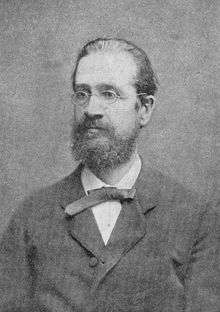
- Martti Ahtisaari (born 1937 in Viipuri), 10th President of Finland, 2008 Nobel Peace Prize laureate
- Erik Bruun (born 1926, Viipuri), Finnish graphic designer
- Simo Häyhä (born 1905, Rautjärvi - 2002), Finnish soldier
- Laila Hietamies (born 1938, Viipuri), Finnish writer
- Gustav Hägglund (born 1938 in Viipuri), Finnish general
- Max Jakobson (born 1923 in Viipuri), Finnish diplomat
- Armas Järnefelt (1869, Vyborg – 1958, Stockholm), Finnish composer and conductor
- Gustaf Komppa (1867, Viipuri – 1949), Finnish chemist
- Julius Krohn (1835, Viborg - 1888), Fennoman
- Grigori Kuzmin (1917, Viipuri – 1988), Estonian astronomer
- Edwin Linkomies (1894, Viborg – 1963, Helsinki), Prime Minister of Finland
- Veijo Meri (born 1928, Viipuri), Finnish writer
- Ernst Mielck (born 1877, Viborg – 1899), Finnish composer
- Masa Niemi (1914, Viborg – 1960, Tampere), Finnish comedian
- Algoth Niska (1888, Viborg – 1954), Finnish adventurer
- Juho Niukkanen (1888, Kirvu – 1954, Helsinki), Finnish minister
- Karl Lennart Oesch (1892, Pyhäjärvi – 1978, Helsinki), Finnish general
- Lauri Kristian Relander (1883, Kurkijoki – 1942, Helsinki), 2nd President of Finland
- Usko Santavuori (1922, Viipuri – 2003, Espoo), Finnish radio reporter
- Lauri Törni (1919, Viipuri – 1965, Vietnam), Finnish and American military officer; received the Mannerheim Cross during the Continuation War
- Uno Ullberg (1879, Viipuri –1944, Helsinki), Finnish architect
- Johannes Virolainen (1914, near Viipuri - 2000), Prime Minister of Finland
See also
- Fief of Viborg (1320–1534)
- Viborg and Nyslott County and Kexholm County (1634–1721)
- Karelian Isthmus for the present-day region, which once was the heartland of the province
Further reading
- Sergey Plescheef (1792). "Northern Region: Government of Vyborg". Survey of the Russian Empire. Translated by James Smirnove (3rd ed.). London: J. Debrett. OCLC 4029300 – via Hathi Trust.
- William Henry Beable (1919), "Governments or Provinces of the Former Russian Empire: Viborg", Russian Gazetteer and Guide, London: Russian Outlook
External links
- Luovutettu Karjala- Ceded Karelia. Website
- Sopanen, Olli-Matti. Viipurin läänin historiallinen bibliografia, 1812-1944 Temaattinen kirjallisuusluettelo Suomen autonomian ja itsenäisyyden ajan Viipurin lääniä käsittelevistä teoksista. University of Joensuu, 2004.
- Knipovich, Nikolay. Vyborg gubernia. Brockhaus and Efron Encyclopedic Dictionary.
- История селений. ИКО "Карелия"
| |||||||||||||||||||||||||||||


